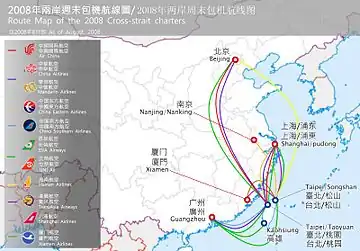First Chen–Chiang summit
The First Chen–Chiang summit (simplified Chinese: 第一次陈江会谈; traditional Chinese: 第一次陳江會談; pinyin: Dì Yī Cì Chén Jiāng Huìtán) was the first of a series of what would later become the Chen-Chiang summit of cross-strait meetings. The meeting was held between the Association for Relations Across the Taiwan Straits (ARATS) represented by Chen Yun-lin and Straits Exchange Foundation (SEF) represented by Chiang Pin-kung. This meeting followed the 1993 Wang-Koo summit.[1]
The summit was a quick meeting that took place on 13 June 2008 in Beijing. Two agreements were signed. The first agreement was signed for weekend cross-strait chartered flights. The second agreement was signed for mainland tourists' travel to Taiwan island.[2] The documents were signed in simplified Chinese characters and traditional Chinese characters and then exchanged.
Both claimed this atmosphere was very different compared to the 1993 Wang-Koo summit, when both were signing for China status.[1] The wife of Chen and the wife of Chiang also entered the summit holding each other's hands and the atmosphere appeared happy.[1]
Meeting
A series of meetings were held between the SEF and the ARATS at Diaoyutai State Guesthouse in Beijing from 11 June 2008 to 14 June 2008. By convention, SEF–ARATS negotiations proceed in three rounds: a technical round led by negotiators seconded from the relevant government departments, a draft round led by deputy heads of the two organizations, and a formal round led by the heads of the two organizations. In this case, however, both sides have already reached broad consensus on these issues on both the technical and political levels through previous negotiations via the non-governmental and inter-party channels. As a result, the initial technical round was dispensed with, and the negotiations began with the second, draft round.[3]
The two sides agreed to the following:

- Initiate direct passenger airline services every weekend from 4 July 2008. Both parties agreed to negotiate the routes of cross-strait direct flights and establish direct communication procedures concerning air traffic management systems as soon as possible. But before the routes of direct flights are finalized, charter flights may temporarily fly across Hong Kong Flight Information Region. There is no need to stop in Hong Kong, but planes still have to fly through its airspace. Weekend charter flights shall fly from each Friday to the following Monday for a total of four full days.
- Opening Taiwan to Chinese tourists. Both parties agreed that Mainland Chinese tourists must travel to Taiwan in groups. Tourists must enter into, visit, and exit from Taiwan in groups. The maximum quota of tourists received by the party responsible for tourist reception shall not exceed the average of 3,000 persons per day, and each group shall consist of a minimum of ten persons and forty persons at the maximum, being in Taiwan for a maximum of ten days.[5]
- However, in 2012, it was agreed by both parties that individual tourists from the PRC cities of Beijing, Shanghai, and Xiamen were allowed to visit Taiwan. Later, tourists from Chengdu, Chongqing, Nanjing, Hangzhou, Guangzhou, and Tianjin were allowed to visit Taiwan individually. Finally, Fuzhou, Jinan, and Xi'an were to join the list by the end of 2012.[6] In 2019, the Chinese government stopped issuing permits for individual tourists to visit Taiwan, amid worsening cross-strait relations.[7]
To facilitate the above, both sides also agreed to further discuss on the possibilities of exchanging representative offices, with an SEF office to be opened in Beijing and an ARATS office in Taipei to issue travel permits to cross-strait visitors, among other duties.
See also
References
- iFeng.comComment. "iFeng.com Archived 2011-07-20 at the Wayback Machine." 兩會復談花絮. Retrieved on 2010-12-18.
- China-embassy.org. "China-embassy.org." Hu Jintao meets taiwan delegation, hails cross-strait talks. Retrieved on 2010-12-18.
- 兩會「跳級」復談 高孔廉VS.孫亞夫 [SEF and ARATS "skip grades" in resuming negotiations; Gao Konglian vs Sun Yafu]. China Times (in Chinese). 11 June 2008. Archived from the original on 3 December 2013. Retrieved 11 June 2008.
- "Full Text of SEF-ARATS Minutes of Talks on Cross-Strait Charter Flights". Straits Exchange Foundation. 13 June 2006. Archived from the original on 13 February 2009. Retrieved 26 October 2008.
- "Full Text of Cross-Strait Agreement Signed Between SEF and ARATS Concerning Mainland Tourists Traveling to Taiwan". Straits Exchange Foundation. 13 June 2006. Archived from the original on 13 February 2009. Retrieved 26 October 2008.
- "Taiwan expands mainland Chinese tourism program". 2 April 2012. Archived from the original on 14 September 2013.
- "Why Taiwan is fine about a decline in mainland Chinese tourists". South China Morning Post. 23 October 2019. Archived from the original on 19 November 2020. Retrieved 7 March 2021.